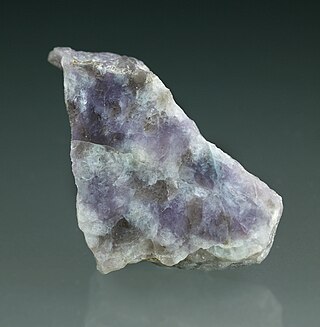Top Qs
Timeline
Chat
Perspective
Rubicline
Rubidium feldspar mineral From Wikipedia, the free encyclopedia
Remove ads
Rubicline, also referred to as Rb-microcline, is the rubidium analogue of microcline, an important tectosilicate mineral. Its chemical formula is (Rb, K)[AlSi3O8] with an ideal composition of RbAlSi3O8. Chemical analysis by electron microprobe indicated the average weight of the crystal is 56.66% SiO2, 16.95% Al2O3, and 23.77% Rb2O,[4] along with trace amounts of caesium oxide (Cs2O) and iron(III) oxide (Fe2O3).[5]
Rubicline was first discovered in 1998 in Elba, Italy, by a team from the University of Manitoba. It was the first mineral to have been discovered with rubidium as an essential constituent.[5] It has also been found in Mozambique[6] and the Kola Peninsula in Russia.[7] Rubicline occurs as small, abundant, rounded grains found within veins of rubidian microcline. Pure rubicline with an ideal potassium-free composition has never been found in nature.[4] Rubicline was synthesized in 2001 by placing powdered albite in a solvent of RbCl. This mixture was then placed in a silver tube containing H2O, heated to 400 °C and pressurized to 60 MPa.[4]
Unlike microcline, which can be yellow, red, or green, rubicline is colorless. It is also transparent, brittle,[5] and has a vitreous luster.[8] Rubicline has been classified as both triclinic and monoclinic.[4][8] The crystal does not show twinning. Other minerals in this group include adularia, anorthoclase, buddingtonite, celsian, hyalophane, microcline, monalbite, orthoclase, and sanidine.[8]
Like all rubidium compounds, rubicline is mildly radioactive. Activity and dose rate of various amounts of rubicline are listed in the table below.[2]
- If held in hand for one hour.
- Government estimate of average annual exposure (360 mRem)
- Max permissible adult dose 50,000 mRem/yr (hands), 15,000 mRem/yr (eyes)
- Lethal exposure 400,000 to 500,000 mRem
Remove ads
References
Wikiwand - on
Seamless Wikipedia browsing. On steroids.
Remove ads

